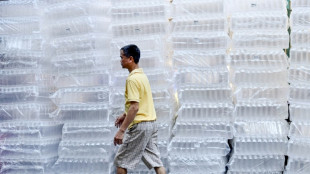
-
 American McNealy takes first PGA title with closing birdie
American McNealy takes first PGA title with closing birdie
-
Sampaoli beaten on Rennes debut as angry fans disrupt Nantes loss

-
 Chiefs edge Panthers, Lions rip Colts as Dallas stuns Washington
Chiefs edge Panthers, Lions rip Colts as Dallas stuns Washington
-
Uruguayans vote in tight race for president

-
 Thailand's Jeeno wins LPGA Tour Championship
Thailand's Jeeno wins LPGA Tour Championship
-
'Crucial week': make-or-break plastic pollution treaty talks begin

-
 Israel, Hezbollah in heavy exchanges of fire despite EU ceasefire call
Israel, Hezbollah in heavy exchanges of fire despite EU ceasefire call
-
Amorim predicts Man Utd pain as he faces up to huge task

-
 Basel backs splashing the cash to host Eurovision
Basel backs splashing the cash to host Eurovision
-
Petrol industry embraces plastics while navigating energy shift

-
 Italy Davis Cup winner Sinner 'heartbroken' over doping accusations
Italy Davis Cup winner Sinner 'heartbroken' over doping accusations
-
Romania PM fends off far-right challenge in presidential first round

-
 Japan coach Jones abused by 'some clown' on Twickenham return
Japan coach Jones abused by 'some clown' on Twickenham return
-
Springbok Du Toit named World Player of the Year for second time

-
 Iran says will hold nuclear talks with France, Germany, UK on Friday
Iran says will hold nuclear talks with France, Germany, UK on Friday
-
Mbappe on target as Real Madrid cruise to Leganes win

-
 Sampaoli beaten on Rennes debut as fans disrupt Nantes loss
Sampaoli beaten on Rennes debut as fans disrupt Nantes loss
-
Israel records 250 launches from Lebanon as Hezbollah targets Tel Aviv, south

-
 Australia coach Schmidt still positive about Lions after Scotland loss
Australia coach Schmidt still positive about Lions after Scotland loss
-
Man Utd 'confused' and 'afraid' as Ipswich hold Amorim to debut draw

-
 Sinner completes year to remember as Italy retain Davis Cup
Sinner completes year to remember as Italy retain Davis Cup
-
Climate finance's 'new era' shows new political realities

-
 Lukaku keeps Napoli top of Serie A with Roma winner
Lukaku keeps Napoli top of Serie A with Roma winner
-
Man Utd held by Ipswich in Amorim's first match in charge

-
 'Gladiator II', 'Wicked' battle for N. American box office honors
'Gladiator II', 'Wicked' battle for N. American box office honors
-
England thrash Japan 59-14 to snap five-match losing streak

-
 S.Africa's Breyten Breytenbach, writer and anti-apartheid activist
S.Africa's Breyten Breytenbach, writer and anti-apartheid activist
-
Concern as climate talks stalls on fossil fuels pledge

-
 Breyten Breytenbach, writer who challenged apartheid, dies at 85
Breyten Breytenbach, writer who challenged apartheid, dies at 85
-
Tuipulotu try helps Scotland end Australia's bid for Grand Slam

-
 Truce called after 82 killed in Pakistan sectarian clashes
Truce called after 82 killed in Pakistan sectarian clashes
-
Salah wants Liverpool to pile on misery for Man City after sinking Saints

-
 Berrettini takes Italy to brink of Davis Cup defence
Berrettini takes Italy to brink of Davis Cup defence
-
Lille condemn Sampaoli to defeat on Rennes debut

-
 Basel backs splashing the bucks to host Eurovision
Basel backs splashing the bucks to host Eurovision
-
Leicester sack manager Steve Cooper

-
 IPL auction records tumble as Pant, Iyer break $3 mn mark
IPL auction records tumble as Pant, Iyer break $3 mn mark
-
Salah sends Liverpool eight points clear after Southampton scare

-
 Key Trump pick calls for end to escalation in Ukraine
Key Trump pick calls for end to escalation in Ukraine
-
Tuipulotu try helps Scotland end Australia's bid for a Grand Slam

-
 Davis Cup organisers hit back at critics of Nadal retirement ceremony
Davis Cup organisers hit back at critics of Nadal retirement ceremony
-
Noel in a 'league of his own' as he wins Gurgl slalom

-
 A dip or deeper decline? Guardiola seeks response to Man City slump
A dip or deeper decline? Guardiola seeks response to Man City slump
-
Germany goes nuts for viral pistachio chocolate

-
 EU urges immediate halt to Israel-Hezbollah war
EU urges immediate halt to Israel-Hezbollah war
-
Far right targets breakthrough in Romania presidential vote

-
 Basel votes to stump up bucks to host Eurovision
Basel votes to stump up bucks to host Eurovision
-
Ukraine shows fragments of new Russian missile after 'Oreshnik' strike

-
 IPL auction records tumble as Pant and Iyer snapped up
IPL auction records tumble as Pant and Iyer snapped up
-
Six face trial in Paris for blackmailing Paul Pogba


China lunar probe takes off from Moon carrying samples
A module of a Chinese lunar probe successfully took off from the far side of the Moon on Tuesday carrying samples to be taken back to Earth, state media reported.
The achievement is a world first, and the latest leap for Beijing's decades-old space programme, which aims to send a crewed mission to the Moon by 2030.
The ascender module of the Chang'e-6 probe "lifted off from lunar surface", state news agency Xinhua said, citing the China National Space Administration (CNSA).
It described it as "an unprecedented feat in human lunar exploration history".
"The mission has withstood the test of high temperature on the far side of the moon," the CNSA said.
After lift-off, the module "entered a preset orbit around the moon", it added.
The Chang'e-6 module touched down on Sunday in the Moon's immense South Pole-Aitken Basin, one of the largest known impact craters in the solar system, according to the CNSA.
The probe's technically complex 53-day mission began on May 3.
The Chang'e-6 features two methods of sample collection: a drill to collect material under the surface and a robotic arm to grab specimens above the surface.
After successfully gathering its samples, "a Chinese national flag carried by the lander was unfurled for the first time on the far side of the moon", Xinhua said.
Scientists say the Moon's dark side -- so-called because it is invisible from Earth, not because it never catches the sun's rays -- holds great promise for research because its craters are less covered by ancient lava flows than the near side.
Material collected from the far side may better shed light on how the Moon formed in the first place.
- 'Space dream' -
Plans for China's "space dream" have been put into overdrive under President Xi Jinping.
Beijing has poured huge resources into its space programme over the past decade, targeting a string of ambitious undertakings in an effort to close the gap with the two traditional space powers -- the United States and Russia.
It has notched several notable achievements, including building a space station called Tiangong, or "heavenly palace".
Beijing has landed robotic rovers on Mars and the Moon, and China is only the third country to independently put humans in orbit.
But Washington has warned that China's space programme is being used to mask military objectives and an effort to establish dominance in space.
China aims to send a crewed mission to the Moon by 2030 and plans to build a base on the lunar surface.
The United States is also planning to put astronauts back on the Moon by 2026 with its Artemis 3 mission.
J.Fankhauser--BTB




